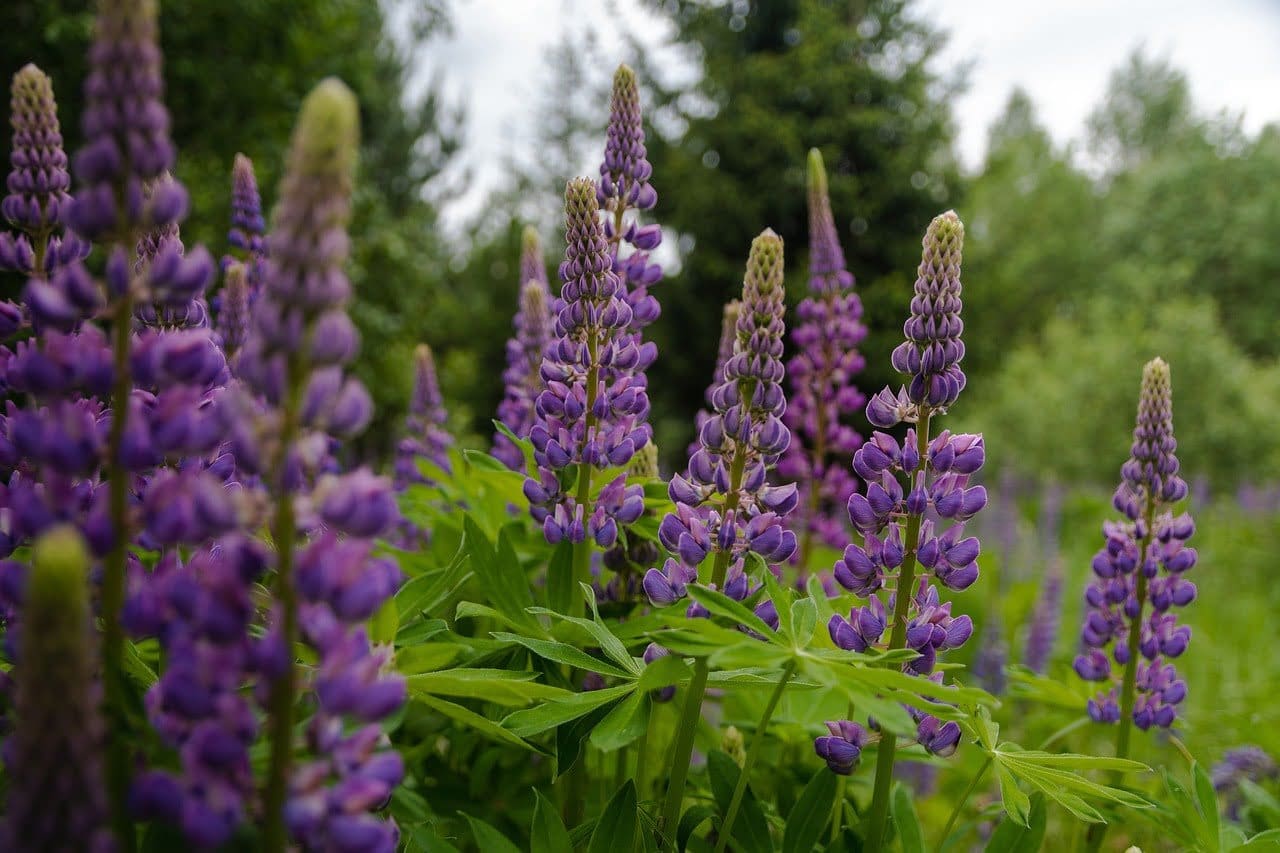Lupin seeds will need to be sown in March or April and plants will need hardening off during May before being planted out after all risk of frost has passed at the end of May.
Are you yearning to add an eye-catching splash of colour to your garden? If yes, then lupins are your go-to plants. Not only are they easy and inexpensive to grow from seeds, but they’re also perennials that return year after year to give your garden a vibrant, cottage-like feel.
Growing over a meter tall, these beauties are irresistible to pollinators, thus helping to maintain a healthy garden ecosystem.
How to Grow Lupins from Seed
Let’s embark on a journey to sprout these seeds into majestic lupins. Here’s our four-step guide: Sowing, hardening off, planting out, and post-planting care.
1. Sowing the Lupin Seeds

To start, give your lupin seeds a good soak overnight. This will soften their hard outer shell, thus aiding successful germination. Aim to sow your seeds between March and April.
In each 9cm pot filled with multipurpose compost, plant two lupin seeds, about 1cm deep. Kept at room temperature, these seeds should spring to life within 10 to 15 days.
Top Tip
Seeds can produce lupins of varying colours. So, if you’re after a specific colour, you might prefer to propagate from cuttings of existing plants.
2. Hardening Off the Lupins


Before introducing your lupin sprouts to the great outdoors, we must harden them off for 1-2 weeks. As the final frost date (usually the end of May) approaches, gradually expose your lupins to outdoor conditions. This process equips them to withstand environmental changes, reducing potential stress.
3. Planting Out the Lupins


After a fortnight of hardening off, your lupins are ready to conquer the outdoors. Ideally, select a sunny spot in your garden with free-draining soil.
These plants can handle a bit of shade, but steer clear of waterlogged areas. Remember, we’re aiming for the end of May, once the frost threat has passed.
4. Taking Care of Your Lupins


Luckily, lupins are low-maintenance plants. They’ll thrive with ample sunshine and well-drained soil.
You can enjoy their vibrant blooms from May to August, provided you regularly remove fading flowers (deadheading). Unless your garden is particularly windy, there’s no need for staking.
In autumn, cut back your lupin plants right down to the ground. However, remember to harvest any seeds if you’d like to sow more next spring.
Your Lupin-Growing Checklist
- Soak lupin seeds overnight before sowing.
- In a 9cm pot filled with compost, sow two seeds, about 1cm deep.
- Start hardening off young plants in May.
- Once the frost threat is over, plant your lupins in a sunny, well-draining spot.
Propagating Lupins from Cuttings
To keep the same colour as the parent plant, propagating lupins from cuttings is a solid bet. Simply use a sharp knife to take a 10cm cutting from new shoots at the base of the plant. Remove lower leaves, then insert the cuttings into a small pot of compost or vermiculite. Keep them on a windowsill or in a greenhouse. Once they’ve grown enough, harden them off before planting out in the garden.
The Many Benefits of Lupins


The perks of adding lupins to your garden go beyond their aesthetic appeal. Here’s why you’ll love having these plants in your space:
Pollinator-Friendly
Lupins attract a variety of pollinators, such as bees and butterflies. By including these plants in your garden, you’re helping support a healthy ecosystem and promote biodiversity.
Soil Enricher
Like other legumes, lupins have a magical ability to fix nitrogen in the soil. This enhances soil fertility, paving the way for healthier growth of surrounding plants.
Versatile Beauty
Lupins come in an array of colours, shapes, and sizes, offering endless possibilities to style your garden. Whether you desire a traditional cottage garden feel or a modern landscape design, there’s a lupin variety to suit your needs.
Hardy and Robust
Lupins are tough and resilient plants. Once established, they can tolerate a range of conditions, making them a wonderful low-maintenance choice for your garden.
Edible and Medicinal
While not all varieties are safe to eat, certain lupins produce seeds that can be used as a protein-rich food source when appropriately prepared. They’re also known for their traditional medicinal uses.
Final thoughts
Sprucing up your garden with lupins is a gardening venture worth undertaking. Not only will you bask in the breathtaking beauty these plants offer, but you’ll also revel in the knowledge that you’re promoting a healthy garden ecosystem. Their low maintenance, resilience, and charm make them a delightful addition to any garden.
Whether you’re propagating from cuttings or starting with seeds, growing lupins is a rewarding endeavour that you’ll likely enjoy season after season.
So why wait? Unleash your inner gardener and let the world of lupins inspire and delight you. After all, the sight of these majestic blooms swaying gently in the breeze is nothing short of a garden lover’s dream come true!
Frequently Asked Questions
Q: Do lupins come back every year?
Yes, lupins are perennials, which means they grow back year after year. After the first bloom, they’ll die back during winter, then re-emerge stronger in spring, giving you a yearly display of stunning flowers.
Q: Do you cut lupins back after flowering?
Absolutely! This process, known as deadheading, involves removing spent flowers to encourage more blooms. It’s also a good idea to cut your lupins back to the ground in autumn, which helps them sprout anew in spring.
Q: Can you leave lupins in the ground over winter?
Yes, you can. Lupins are pretty hardy and can withstand the chill of winter. Simply cut them back in autumn, and they’ll go dormant over winter, ready to burst into life again when spring arrives.
Q: Do slugs eat lupins?
Unfortunately, slugs do find lupins quite tasty. To protect your plants, consider using slug deterrents, such as copper tape or slug pellets, or natural methods like introducing slug-eating critters (like birds or beetles) to your garden.
Q: Will lupins spread?
Lupins can self-seed under the right conditions, which might result in them spreading throughout your garden. However, they are not particularly aggressive spreaders. If you want to control their distribution, deadhead the flowers before they set seed or simply remove any unwanted seedlings that appear.







